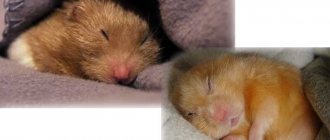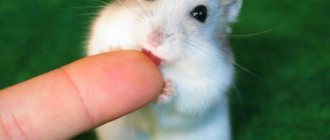Hamsters are fairly hardy pets, but they are so small that if injured or sick, things can quickly become serious.
It is useful to know the most common signs of the disease in order to solve the problem as quickly as possible. It is often possible to treat an illness or injury before it becomes life-threatening.
The most common signs of illness or injury in hamsters
Hamsters usually exhibit one or more of these signs when coping with illness or injury.
loss of appetite inactivity huddling in a corner a disheveled or unkempt coat sneezing, wheezing and/or discharge from the nose or eyes wetness around the tail diarrhea hair loss (often a sign of parasites or allergies)
If your hamster is sick or injured, keep him warm and have him take some food or water (using a dropper if necessary) until the veterinarian arrives.
Hamster abscesses
Abscesses are pockets of infection that can form due to minor breaks in the skin. Pus accumulates under the skin, sometimes forming a large lump that sometimes begins to drain on its own.
Abscesses can form from cuts or scrapes in the skin or in the cheek pouches if an abrasive food material causes scratches on the lining of the mouth.
If your hamster constantly looks like he has food in his cheek pouches, this may indicate an abscess or damaged cheek pouch. Abscesses require the attention of a veterinarian for drainage, irrigation, and treatment with antibiotics.
Respiratory infections in hamsters
Hamsters can get respiratory infections that can lead to pneumonia. Signs of a respiratory infection include sneezing, discharge from the eyes or nose, wheezing, and difficulty breathing.
Occasional sneezing is not too concerning, but if there is loss of appetite, decreased activity, wheezing or difficulty breathing, contact your veterinarian immediately.
Warning
Drafts and sudden changes in temperature can put your hamster at risk of developing a respiratory infection, and some types of bedding (such as cedar and pine) can irritate the respiratory tract, which can also lead to infection.
How to prevent an animal's early death
To extend the life of a rodent, follow a number of recommendations:
- Give your pet only food that is suitable for him. Food from the owners' table can harm the animal's health and cause severe discomfort, illness, and death. The food must be fresh.
- Keep the cage clean.
- Eliminate potential sources of stress whenever possible. Noisy electrical appliances, cats, and dogs should not enter the room where the hamster lives.
- At home, you should not wash rodents unless necessary. The cage must be placed in a warm, but not too hot place.
- Play with your hamster regularly and take care of it. The animal must feel the love of its owners.
- Take your pet to the veterinarian periodically. The doctor will be able to detect the symptoms of dangerous diseases in time and tell you what to do to prolong the life of the animal.
- Don't breed females too early.
Visit your veterinarian regularly with your pet.
Wet tail in hamsters
Wet tail, also called proliferative ileitis and regional enteritis, is a highly contagious disease and most often occurs in recently weaned hamsters. The cause is unclear, but a bacteria called Campylobacter jejuni may be involved, and in some cases the disease is associated with stress, overcrowding and changes in diet.
Affected hamsters can die very quickly, showing signs such as diarrhea (causing wetness around the tail), lethargy, loss of appetite and ruffled fur. Not all hamsters with diarrhea have a wet tail, but if your hamster has any of these symptoms, you should seek help from your veterinarian.
Proper nutrition
There is a wide variety of food for rodents on display at pet stores. However, despite what the labels say, not all of them are created equal. Cheap food is not suitable for feeding hamsters - they are usually of poor quality, incorrectly balanced, and do not contain all the necessary substances and vitamins. There have been cases where rodent poison was found in food, which caused the death of pets.
For normal functioning, hamsters need balanced dry food. It should include cereals, plant seeds, herbs and flowers, as well as protein supplements in the form of dried insects.
It is important to give hamsters allowed vegetables and fruits. You can feed hamsters cucumber, zucchini, broccoli, cauliflower, lettuce, turnips, radish. Types of hamsters that are not predisposed to diabetes can be given pumpkin, carrots, fruits and dried fruits.
It is forbidden to give onions, white cabbage, sorrel.
Diarrhea in hamsters
A number of infections can cause diarrhea, including but not limited to wet tail, dietary changes, intestinal parasites, and antibiotic treatment. Overfeeding vegetables and other fresh foods is a common cause of diarrhea, but there is usually no loss of appetite or decreased activity.
Dehydration is a serious problem any time your hamster has diarrhea, so make sure he is still drinking water if this happens.
If you have diarrhea, avoid eating fresh foods for a few days and only resume offering them once the diarrhea has completely resolved. Then slowly reintroduce fresh foods so your hamster can slowly adjust to the changes in diet.
If lethargy or lack of water occurs along with diarrhea, you should seek help from your veterinarian.
Reasons caused by temperature violations
To understand whether your hamster is sick and what to do if it does not move, carefully examine the furry animal. If the pet breathes calmly and evenly with his eyes closed, and this state was not preceded by symptoms of the disease, it is obvious that this is hibernation, similar to the one that hamsters fall into in the natural environment.
Staying in a “coma” allows them to save their lives during the cold period (with a lack of food and insufficient lighting). If the cause of this condition is overheating of the animal’s body, then this is much more dangerous than hypothermia. A furry pet's body does not have protective mechanisms to withstand heat or sunstroke. Overheating, in most cases, provokes death.
Did you know? The name "hamster" comes from the old German word "hamstern", which translates to "treasure".
Heatstroke
The natural habitat of the Djungarian hamster is the steppe, and the Syrian hamster is semi-desert, but the body of these rodents is defenseless against overheating as a result of extreme heat - the body is covered with thick fur, does not secrete sweat, and the animal does not have a function that allows it to breathe through the mouth. Rodents cannot tolerate high air temperatures, and exposure to direct sunlight is harmful to them. At increased risk are obese, elderly, pregnant and confined individuals.
Symptoms that indicate overheating include:
- immobility - the animal lies on its side;
- heavy breathing with an open mouth;
- trembling body;
- red eyes and mouth;
- increased body temperature;
- weakened and “indifferent” state;
- the rodent twitches, which indicates the presence of convulsions.
Preexisting unfavorable conditions may contribute to the condition of heat stroke:
- transportation of the ward in a car;
- placing the cage with the pet on a windowsill or balcony, where the baby is not protected from direct sunlight, or near heating appliances;
- the room where the rodent lives has not been ventilated for a long time and has a high level of humidity.
The maximum permissible temperature at which a furry pet cannot exist permanently, but only for 2-3 days, is +28°C.
Important! Due to heat stroke, the animal dies in most cases. To save him, it is advisable to take measures immediately.
If your pet overheats, begin providing first aid yourself.
- Cool the animal's body without a sudden drop in temperature. To do this, you can place the animal on a damp towel, tile, or on the surface of a ceramic dish, moisten the ears and paws with cool water. Do not use ice cubes to wipe the fur. It is forbidden to immerse a rodent in cold water. Such a temperature change can trigger a heart attack, which can lead to death.
- The cause of overheating may be dehydration of the pet's body. To replenish the lack of vital fluid in an immobile rodent, sterile Ringer's solution or sodium chloride is injected under the skin. The dosage of the medicine varies depending on the type of animal. So, the Syrian and representatives of other large breeds are injected with 4–8 ml; the Djungarian, which is small in size, will need 2 ml. The baby will become vigorous and cheerful after a few days, during which problems with coordination are still usually observed.
- It is not recommended to start anti-shock therapy before the arrival of a ratologist. If the condition of your ward becomes more and more critical, then you can use Prednisolone with a concentration of 30 mg/ml, as well as an insulin syringe and give an injection into the muscle of the hind leg: for a Syrian hamster - 0.1 ml, for a Djungarian hamster - 0.05 ml. If the animal experiences convulsions, then it is given one drop of No-shpa; if it loses consciousness, it is given the same amount of Dexamethasone. For large Syrian rodents, double the dose. Then the therapy is continued, drinking Traumeel S 1-2 drops twice a day. Ensure the temperature in the room is within +24...+26°C, feed your pet three times a day for 3 days with a cocktail of Gamavit, saline solution and five percent glucose - two drops of each substance.
The temperature at which proteins coagulate in the blood and organs of a hamster is +44°C.
It is critical, so the pet is almost impossible to save. If the patient’s body temperature persists for quite a long time, then there is no hope for a favorable outcome. Death can be instantaneous or after a few days, during which all body functions gradually fade away. Important! To check the degree of dehydration, pull the animal's fur upward. If she continues to stand and does not return to her previous position, then this indicates an unsatisfactory condition of the body.
If the rodent managed to survive, then in the first day after heat or sunstroke, residual effects of overheating may be observed: the animal lies on its side and barely moves. Neurological disorders are caused by swelling of brain tissue. If the outcome is favorable, problems with coordination will gradually disappear.
Coma or hibernation
The cause of the hamster's state of torpor may be a low temperature background in the room where the animal is located. For example, as a result of turning off the heating or as a result of leaving a window open for a long time in winter. A lack of food for 2-3 days can also provoke a “coma” or hibernation. During this state, the animal's body will be cool to the touch, but soft. This means he is alive. To determine the heart rate, use your thumb and forefinger to grasp the hamster's chest under the paws.
The heart beat in a coma is slow—about one beat every fifteen seconds. The breathing intensity of a sleeping hamster with its eyes closed is quite difficult to determine due to its small size - it is calm and even. In the wild, with the arrival of cold weather, individuals of the Hamster family begin to hibernate. Thus, they manage to survive the winter season with short daylight hours and no opportunity to get food.
Important! Avoid being in a coma
-
to do this, ensure the temperature in the room with the rodent’s home is above +20°C, as well as the penetration of a sufficient amount of sunlight into its cage, not forgetting to regularly fill the feeder and drinker.
To awaken the patient, the cage is placed in a room where the air temperature is not lower than +20°C. After 2-3 days the rodent wakes up. By the time you wake up, fill the feeder and water bowl. After hibernation, the rodent has little energy, so it rushes to make up for its lack by eating intensively. If your pet does not receive enough food after hibernation, this can lead to serious liver problems. Such a long awakening of a rodent is similar to how it wakes up in natural conditions of existence.
You can “raise” a pet from hibernation faster:
- Wrap your pet in warm wool or downy fabric, place it in its home and move it to a room with high air temperatures.
- You can fill 3-5 plastic bottles with hot water. Place them in a row and place a cage on top. The heat will keep the hamster warm in his home.
If, after waking up from a “coma,” the animal walks poorly, sneezes, coughs, and has a wet tail due to diarrhea, be sure to consult a veterinarian. The best option would be for a doctor to visit your home to examine the rodent, because the baby is not yet ready for transportation after hibernation.
Skin diseases in hamsters
Hamsters can be infested with a variety of skin and fur mites, which can be diagnosed by a skin scraping performed by a veterinarian. Ringworm, fungal infection, allergic dermatitis and skin infections can also occur on the skin and require treatment by a veterinarian.
Hair loss is not unusual and may be seasonal or occur in older hamsters. But if the skin develops flaking, redness or any lesions, or if your hamster itches more than usual, you should contact your veterinarian.
Hamsters do have scent glands on their sides, which can be dark and sometimes alarming to owners. They occur on both sides of the body and should not cause irritation or bother the hamster. Cedar bedding can also cause skin irritation and should be avoided.
Tips for coping with the loss of a pet
The lifespan of rodents is short. Children who have lost a pet are very worried, and parents do not know how to help them, how to survive the death of a hamster.
To make it easier to come to terms with your loss, follow these recommendations:
- Do not hide from your child that your pet has passed away. He has to learn that animals die one day and it is impossible to revive them. Lying can lead to loss of trust in parents.
- Don't hold back your feelings and don't stop your children. They need to mourn their lost pet.
- Reminisce with your child about happy moments associated with animals.
You shouldn't get a new pet right away. It’s better to let the heartache pass and only then go for a new furry friend.











